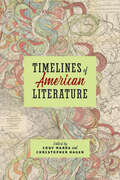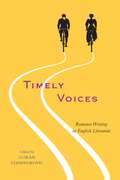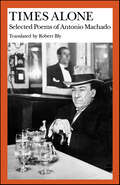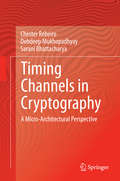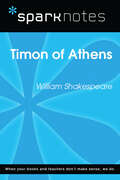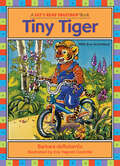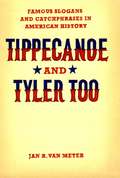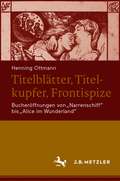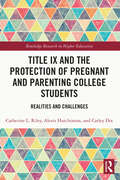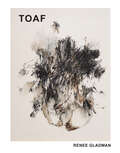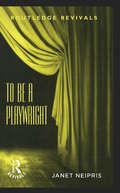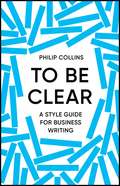- Table View
- List View
Timelines of American Literature
by Cody Marrs and Christopher HagerA collection of engaging essays that seeks to uniquely reperiodize American literature.It is all but inevitable for literary history to be divided into periods. "Early American," "antebellum," "modern," "post-1945"—such designations organize our knowledge of the past and shape the ways we discuss that past today. These periods tend to align with the watershed moments in American history, even as the field has shifted its perspective away from the nation-state. It is high time we rethink these defining periods of American literary history, as the drawing of literary timelines is a necessary—even illuminating—practice.In these short, spirited, and imaginative essays, 23 leading Americanists gamely fashion new, unorthodox literary periods—from 600 B.C.E. to the present, from the Age of Van Buren to the Age of Microeconomics. They bring to light literary and cultural histories that have been obscured by traditional timelines and raise provocative questions. What is our definition of "modernism" if we imagine it stretching from 1865 to 1965 instead of 1890 to 1945? How does the captivity narrative change when we consider it as a contemporary, not just a "colonial," genre? What does the course of American literature look like set against the backdrop of federal denials of Native sovereignty or housing policies that exacerbated segregation? Filled with challenges to scholars, inspirations for teachers (anchored by an appendix of syllabi), and entry points for students, Timelines of American Literature gathers some of the most exciting new work in the field to showcase the revelatory potential of fresh thinking about how we organize the literary past.
Timely Voices: Romance Writing in English Literature
by Goran StanivukovicA reassessment of romance as a resource and strategy of writing that transformed itself across time and texts, and that fascinated writers from medieval to modern times.
Times Alone: Selected Poems of Antonio Machado (Wesleyan Poetry in Translation)
by Antonio MachadoAntonio Machado, a school teacher and philosopher and one of Spain's foremost poets of the twentieth century, writes of the mountains, the skies, the farms and the sentiments of his homeland clearly and without narcissism: "Just as before, I'm interested/in water held in;/ but now water in the living/rock of my chest." "Machado has vowed not to soar too much; he wants to 'go down to the hells' or stick to the ordinary," Robert Bly writes in his introduction. He brings to the ordinary—to time, to landscape and stony earth, to bean fields and cities, to events and dreams—magical sound that conveys order, penetrating sight and attention. "The poems written while we are awake…are more original and more beautiful, and sometimes more wild than those made from dreams," Machado said. In the newspapers before and during the Spanish Civil War, he wrote of political and moral issues, and, in 1939, fled from Franco's army into the Pyrenees, dying in exile a month later. When in 1966 a bronze bust of Machado was to be unveiled in a town here he had taught school, thousands of people came in pilgrimage only to find the Civil Guard with clubs and submachine guns blocking their way. This selection of Machado's poetry, beautifully translated by Bly, begins with the Spanish master's first book, Times Alone, Passageways in the House, and Other Poems (1903), and follows his work to the poems published after his death: Poems from the Civil War (written during 1936 – 1939).
Timing Canada The Shifting Politics of Time in Canadian Literary Culture
by Paul HuebenerFrom punch clocks to prison sentences, from immigration waiting periods to controversial time-zone boundaries, from Indigenous grave markers that count time in centuries rather than years, to the fact that free time is shrinking faster for women than for men - time shapes the fabric of Canadian society every day, but in ways that are not always visible or logical. In Timing Canada, Paul Huebener draws from cultural history, time-use surveys, political statements, literature, and visual art to craft a detailed understanding of how time operates as a form of power in Canada. Time enables everything we do - as Margaret Atwood writes, "without it we can't live." However, time also disempowers us, divides us, and escapes our control. Huebener transforms our understanding of temporal power and possibility by using examples from Canadian and Indigenous authors - including Jeannette Armstrong, Joseph Boyden, Dionne Brand, Timothy Findley, Lucy Maud Montgomery, Gabrielle Roy, and many others - who witness, question, dismantle, and reconstruct the functioning of time in their works. As the first comprehensive study of the cultural politics of time in Canada, Timing Canada develops foundational principles of critical time studies and everyday temporal literacy, and demonstrates how time functions broadly as a tool of power, privilege, and imagination within a multicultural and multi-temporal nation.
Timing Canada: The Shifting Politics of Time in Canadian Literary Culture
by Paul HuebenerTime as a form of power in Canadian society, literature, and cultural imagination.
Timing Channels in Cryptography
by Chester Rebeiro Debdeep Mukhopadhyay Sarani BhattacharyaThis book deals with timing attacks on cryptographic ciphers. It describes and analyzes various unintended covert timing channels that are formed when ciphers are executed in microprocessors. The book considers modern superscalar microprocessors which are enabled with features such as multi-threaded, pipelined, parallel, speculative, and out-of order execution. Various timing attack algorithms are described and analyzed for both block ciphers as well as public-key ciphers. The interplay between the cipher implementation, the system architecture, and the attack's success is analyzed. Further hardware and software countermeasures are discussed with the aim of illustrating methods to build systems that can protect against these attacks.
Timon of Athens (SparkNotes Literature Guide Series)
by SparkNotesTimon of Athens (SparkNotes Literature Guide) by William Shakespeare Making the reading experience fun! Created by Harvard students for students everywhere, SparkNotes is a new breed of study guide: smarter, better, faster. Geared to what today's students need to know, SparkNotes provides: *Chapter-by-chapter analysis *Explanations of key themes, motifs, and symbols *A review quiz and essay topicsLively and accessible, these guides are perfect for late-night studying and writing papers
Timon of Athens: A Tragedy - Primary Source Edition (The Pelican Shakespeare)
by William ShakespeareThe acclaimed Pelican Shakespeare series edited by A. R. Braunmuller and Stephen Orgel The legendary Pelican Shakespeare series features authoritative and meticulously researched texts paired with scholarship by renowned Shakespeareans. Each book includes an essay on the theatrical world of Shakespeare’s time, an introduction to the individual play, and a detailed note on the text used. Updated by general editors Stephen Orgel and A. R. Braunmuller, these easy-to-read editions incorporate over thirty years of Shakespeare scholarship undertaken since the original series, edited by Alfred Harbage, appeared between 1956 and 1967. With definitive texts and illuminating essays, the Pelican Shakespeare will remain a valued resource for students, teachers, and theater professionals for many years to come. For more than seventy years, Penguin has been the leading publisher of classic literature in the English-speaking world. With more than 1,700 titles, Penguin Classics represents a global bookshelf of the best works throughout history and across genres and disciplines. Readers trust the series to provide authoritative texts enhanced by introductions and notes by distinguished scholars and contemporary authors, as well as up-to-date translations by award-winning translators.
Timothy Findley and the Aesthetics of Fascism: Intertextual Collaboration and Resistance
by Anne Geddes BaileyThese essays explore the troubling relationship between narrative meaning and representations of violence within Findley's novels.<P><P> Although Findley clearly admires the modernist texts which appear in his own fiction, his novels also reveal how the modernist search for metaphoric unity and meaning in the face of real social and political fragmentation often reflects an aesthetic akin to that of fascism.
Tiny Tiger: Long Vowel I (Let's Read Together ®)
by Barbara deRubertisLet&’s Read Together books merge rhyme and vowel sounds in delightfully zany stories kids will want to read again and again. Each of the 15 books in this classic series by award-winning author/educator Barbara deRubertis will give your child a jumpstart on reading success."Story lines are silly and inventive, and recall Dr. Seuss&’s Cat in the Hat for the building of rhythm and rhyming words." —School Library JournalTiny Tiger takes some advice from a wise lion and learns not to be so shy. (This easy-to-read story features the long &“i&” vowel sound.)
Tippecanoe and Tyler Too: Famous Slogans and Catchphrases in American History
by Jan R. Van MeterIn individual entries on slogans and catchphrases from the early seventeenth to the late twentieth century, Jan Van Meter reveals that each one is a living, malleable entity that has profoundly shaped and continues to influence our public culture. From John Winthrop's "We shall be as a city upon a hill" to Martin Luther King Jr.'s "I have a dream" and Ronald Reagan's "Mr. Gorbachev, tear down this wall", each of Van Meter's selections emerges as a memory device for a larger political or cultural story. Taken together in Van Meter's able hands, these famous slogans and catchphrases give voice to our common history even as we argue about where it should lead us.
Titelblätter, Titelkupfer, Frontispize: Bucheröffnungen von "Narrenschiff" bis "Alice im Wunderland"
by Henning OttmannWer Hobbes‘ Leviathan in Händen hält und findet das Titelblatt nicht, ist mit recht enttäuscht. Henning Ottmann widmet sich in diesem Buch den Frontispizen und Titelblättern, die über mehrere Jahrhunderte hinweg wichtige Bestandteile der Paratexte von Büchern waren. Sie können etwas verraten über die Intention des Autors, über Inhalt und Selbstrepräsentation, sie sind Ausdruck einer Lust am Rätsel, sie dienten aber auch als Selbstschutz in Zeiten von Zensur sowie der Übermittlung geheimer Botschaften, die nicht in Worte gefasst werden konnten. Der Künstler selbst kann als erster Leser des Werkes die weitere Rezeption durch seine Interpretation maßgeblich beeinflussen. Bisher gibt es keine systematische Erforschung, keine Kataloge, Handbücher oder nach Fächern gegliederte Datenbanken. Dieses Buch unternimmt nun einen ersten Schritt in diese Richtung und beschränkt sich dabei nicht auf eine Disziplin. Das mag wie ein Potpourri erscheinen – soll aber einfach Lust an mehr wecken! – Mit zahlreichen, zum Teil farbigen Abbildungen.
Title IX and the Protection of Pregnant and Parenting College Students: Realities and Challenges (Routledge Research in Higher Education)
by Catherine L. Riley Alexis Hutchinson Carley DixThis book explores the discrepancies among what protections Title IX provides to pregnant and parenting students, what colleges communicate, and what pregnant and parenting students actually experience. To actually protect pregnant and parenting students, the authors argue that a school must provide multifaceted support that is effectively communicated to an entire campus community, including students who are parenting, who are pregnant, and who may become pregnant. The first part of the book portrays the realities of pregnancy and parenting in college. The chapters illuminate related Title IX applications, population demographics, how unplanned pregnancies in college occur, and physical and mental health challenges that these students often experience. The authors then discuss what compliance with Title IX legally entails and why meeting it is often an afterthought. In the second half of the book, the authors use mixed-methods research to map the compliance landscapes of three schools in the southeast as examples: a large state school, a mid-size private university, and a small private college. Offering eye-opening interviews with pregnant and parenting students, interdisciplinary research, and proposals for multifaceted support and communication on college campuses, this volume will engage students, scholars, and activists with an interest in higher education administration, educational policy, reproductive health, bioethics, gender studies, and rhetoric.
Titus Andronicus (SparkNotes Literature Guide Series)
by SparkNotesTitus Andronicus (SparkNotes Literature Guide) by William Shakespeare Making the reading experience fun! Created by Harvard students for students everywhere, SparkNotes is a new breed of study guide: smarter, better, faster. Geared to what today's students need to know, SparkNotes provides: *Chapter-by-chapter analysis *Explanations of key themes, motifs, and symbols *A review quiz and essay topicsLively and accessible, these guides are perfect for late-night studying and writing papers
Titus Andronicus: Critical Essays (Shakespearean Criticism)
by Philip C. KolinOriginally published in 1995. In three parts – introduction, criticism and reviews – this volume examines the goriest of Shakespeare’s works. The editor’s exhaustive introduction runs through the pattern of changing scholarship and commentary, introducing the key interests in the play, from its authorship to its language, rhetoric and performance. Early commentaries focused on arguing about whether the play was truly Shakespeare’s. A selection of the most important of these are included here followed by later investigations looking at myriad topics and characters – revenge, violence, race, Aaron, women, tragedy and Tamora. The large section of reviews of stage performances, arranged chronologically, ranges from 1857 to 1990. Two final pieces interestingly survey stage history of Titus in Japan and in Germany.
To After That (TOAF)
by Renee GladmanA warm-spirited elegy to an abandoned work, brilliantly comic and wryly contemplative, by one of the great artist-investigators of our time.Originally published in 2008 in the groundbreaking Atelos series, To After That (TOAF) introduced a new kind of writing—somewhere between criticism and memoir and philosophy—that Renee Gladman has continued to explore in books like Calamities and My Lesbian Novel. TOAF is a recuperative song, an effort to give space and life to an abandoned project, but it is also, itself, a beautiful meditation on process and distance and duration, and a reminder that time is the subject of any writing.
To All Appearances: Ideology and Performance (Routledge Revivals)
by Herbert BlauFirst published in 1992, To All Appearances is a book in which ideology and performance shadow each other, in a theoretical inquiry which ranges widely across historical periods and cultures. The author’s concerns—which include the social meaning of illusion and the cultural manifestation of power—take the reader from Jacobean drama to the pageantry of Robert Wilson; from Eleanora Duse to Laurie Anderson; from the puppet theater of Kleist to Kantor’s theater of the dead; and from the Kutiyattam temple dancers in Kerala to Womanhouse in Los Angeles.A brilliant, uncontainable, and chastening look at the rhetoric of critical theory in relation to performance and ideological practice, this is undoubtedly a book for the twenty-first century. It returns us, through all appearances, to the unavoidable question in art, in politics, in the society of the spectacle: what, after all, is the future of illusion?
To Be A Playwright (Routledge Revivals)
by Janet NeiprisOriginally published in 2005, To Be A Playwright is an insightful and detailed guide to the craft of playwriting. Part memoir and part how-to guide, this useful book outlines the tools and techniques necessary to the aspiring playwright. Comprised of a collection of memoirs and lectures which blend seamlessly to deliver a practical hands-on guide to playwriting, this book illuminates the elusive challenges confronting creators of dynamic expression and offers a roadmap to craft of playwrighting.
To Be Clear
by Philip CollinsThe bad reputation many businesses have in our time is intimately connected to the lack of clarity in the language they use. TO BE CLEAR is a call to arms, urging businesses to stop using the language of nonsense and start using language that has clarity and meaning. It's a lucid, entertaining and practical guide for anyone who cares about language to help them improve their communications and thus also their business practices.
To Be Clear
by Philip CollinsThe bad reputation many businesses have in our time is intimately connected to the lack of clarity in the language they use. TO BE CLEAR is a call to arms, urging businesses to stop using the language of nonsense and start using language that has clarity and meaning. It's a lucid, entertaining and practical guide for anyone who cares about language to help them improve their communications and thus also their business practices.
To Be Continued
by Michele Karlsberg Karen X. TulchinskyCliff-hanger stories by Firebrand Books authors like Judith Katz and Jewell Gomez.
To Be a Playwright
by Janet NeiprisFirst Published in 2006. Routledge is an imprint of Taylor & Francis, an informa company.
To Begin Where I Am: Selected Essays
by Czeslaw Milosz Madeline Levine Bogdana CarpenterThe selection of essays in this book was guided by a desire to represent Milosz's extraordinary thematic breadth as well as the diversity of the genres and styles he commands. The essays are grouped into three sections. Part I, "These Guests of Mine," introduces Milosz through autobiographical accounts and biographical sketches of people who were representative of the historical currents that shaped his life. Part II, "On the Side of Man," presents Milosz as the profoundly serious religious thinker he has always been. Part III, "Against Incomprehensible Poetry," gathers together Milosz's most significant writings on the obligations of poetry and concludes with his assessments of four major poets of the twentieth century.
To Build a Shadowy Isle of Bliss
by Paul Leduc Browne Michelle WeinrothTo Build a Shadowy Isle of Bliss casts new light on the political radicalism and social thought of nineteenth-century artist, author, and revolutionary, William Morris. Standing on the cusp of a new wave of scholarship, this book presents an exciting convergence of views among internationally renowned scholars in the field of Victorian Studies. Balancing variety and unity, this collection reappraises Morris's concept of social change and asks how we might think beyond the institutions and epistemologies of our time. Though the political significance of Morris's creative work is often underestimated, the essays in this volume showcase its subtlety and sophistication. Each chapter discerns the power and novelty of Morris's radicalism within his aesthetic creations and demonstrates how his most compelling political ideas bloomed wherever his dexterous hand had been at work - in wallpapers, floral borders, medievalist romances, and verse. Morris's theory and practice of aesthetic creation can be seen as the crucible of his entire philosophy of social change. In situating Morris's radicalism at the heart of his creative legacy, and in reanimating debates about nineteenth-century art and politics, To Build a Shadowy Isle of Bliss challenges and expands received notions of the radical, the aesthetic, and the political.
To Build a Shadowy Isle of Bliss: William Morris's Radicalism and the Embodiment of Dreams
by Michelle Weinroth Paul Leduc BrowneA powerful reappraisal of radicalism in the life and work of William Morris.
